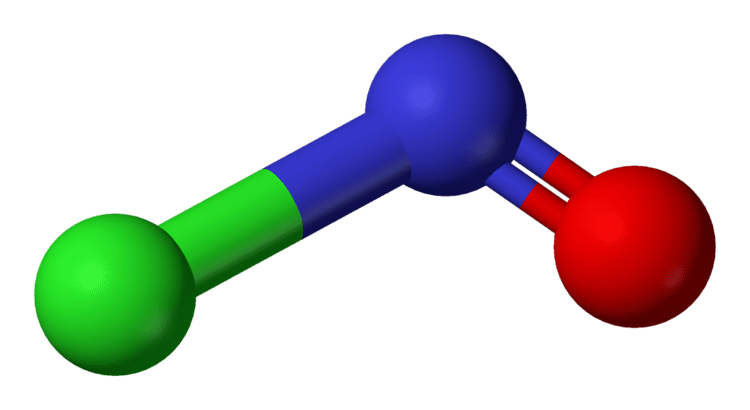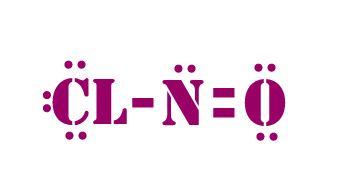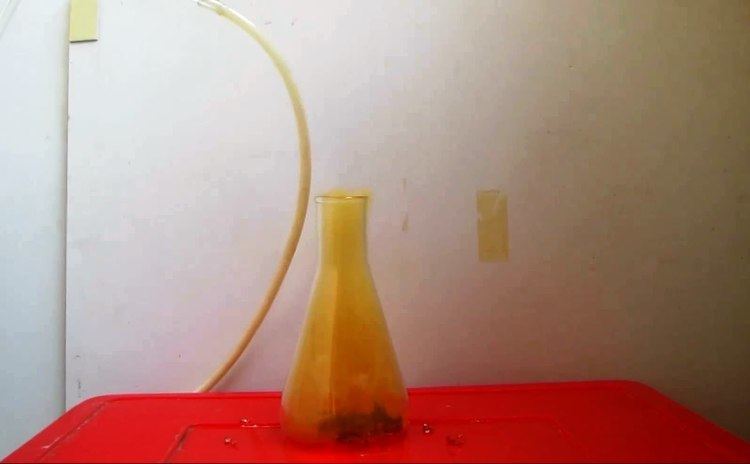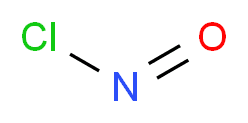Appearance Yellow gas Formula ClNO Boiling point -5.55 °C Melting point -59.4 °C | IUPAC ID Nitrosyl chloride Molar mass 65.46 g/mol Density 1.27 g/cm³ Soluble in Water | |
 | ||
Related compounds | ||
Preparation properties of nitrosyl chloride
Nitrosyl chloride is the chemical compound with the formula NOCl. It is a yellow gas that is most commonly encountered as a decomposition product of aqua regia, a mixture of hydrochloric acid and nitric acid. It is a strong electrophile and oxidizing agent.
Contents
- Preparation properties of nitrosyl chloride
- Structure and synthesis
- Production
- Occurrence in aqua regia
- Reactions
- Applications in organic synthesis
- Industrial applications
- Safety
- References

Structure and synthesis

The molecule is bent. A double bond exists between N and O (distance = 1.16 Å) and a single bond between N and Cl (distance = 1.69 Å). The O–N–Cl angle is 113°.
Production

Since nitrosyl chloride is chemically simple and stable at room temperature and below, it can be produced in many ways.

Occurrence in aqua regia
NOCl also arises from the combination of hydrochloric and nitric acids according to the following reaction:
HNO3 + 3 HCl → Cl2 + 2 H2O + NOCl
In nitric acid, NOCl is readily oxidized into nitrogen dioxide. The presence of NOCl in aqua regia was described by Edmund Davy in 1831.
Reactions

NOCl behaves as an electrophile and an oxidant in most of its reactions. With halide acceptors, for example antimony pentachloride, converts to nitrosonium salts:
NOCl + SbCl5 → [NO]+[SbCl6]−In a related reaction, sulfuric acid gives nitrosylsulfuric acid, the mixed acid anhydride of nitrous and sulfuric acid:
ClNO + H2SO4 → ONHSO4 + HClNOCl reacts with silver thiocyanate to give silver chloride and the pseudohalogen nitrosyl thiocyanate:
ClNO + AgSCN → AgCl + ONSCNNitrosyl chloride is used to prepare metal nitrosyl complexes. With molybdenum hexacarbonyl, NOCl gives the dinitrosyldichloride complex:
Mo(CO)6 + 2 NOCl → MoCl2(NO)2 + 6 COApplications in organic synthesis

Aside from its role in the production of caprolactam, NOCl finds some other uses In organic synthesis. It adds to alkenes to afford α-chloro oximes. The initial addition of NOCl follows the Markovnikov rule. Ketenes also add NOCl, giving nitrosyl derivatives:
H2C=C=O + NOCl → ONCH2C(O)ClPropylene oxide also undergoes electrophilic addition with NOCl to give an α-chloronitritoakyl derivative:

It converts amides to N-nitroso derivatives. NOCl converts some cyclic amines to the alkenes. For example, aziridine reacts with NOCl to give ethene, nitrous oxide and hydrogen chloride.
Industrial applications
NOCl and cyclohexane react photochemically to give cyclohexanone oxime hydrochloride. This process exploits the tendency of NOCl to undergo photodissociation into NO and Cl radicals. The oxide is converted to caprolactam, a precursor to Nylon-6.
Safety
Nitrosyl chloride is very toxic and irritating to the lungs, eyes, and skin. Use safety mask while working with this chemical.
